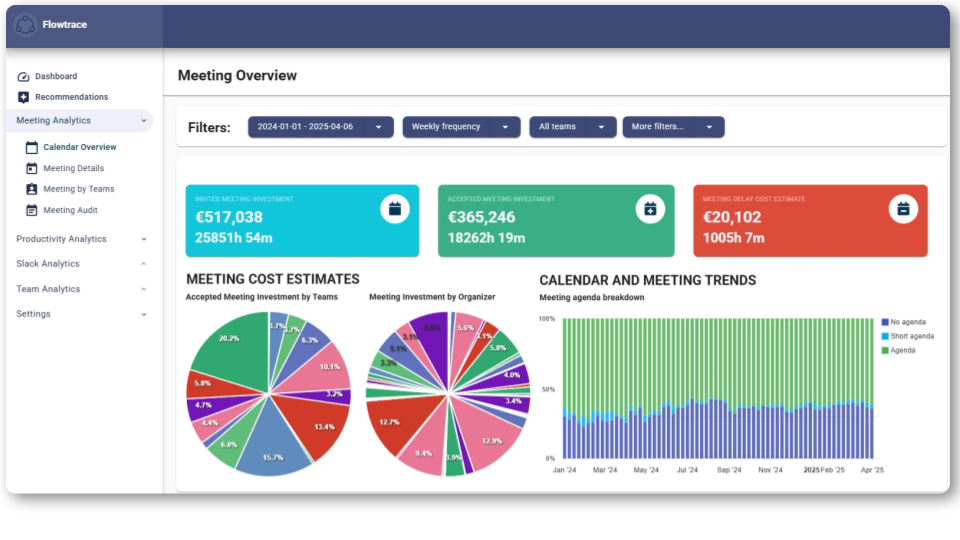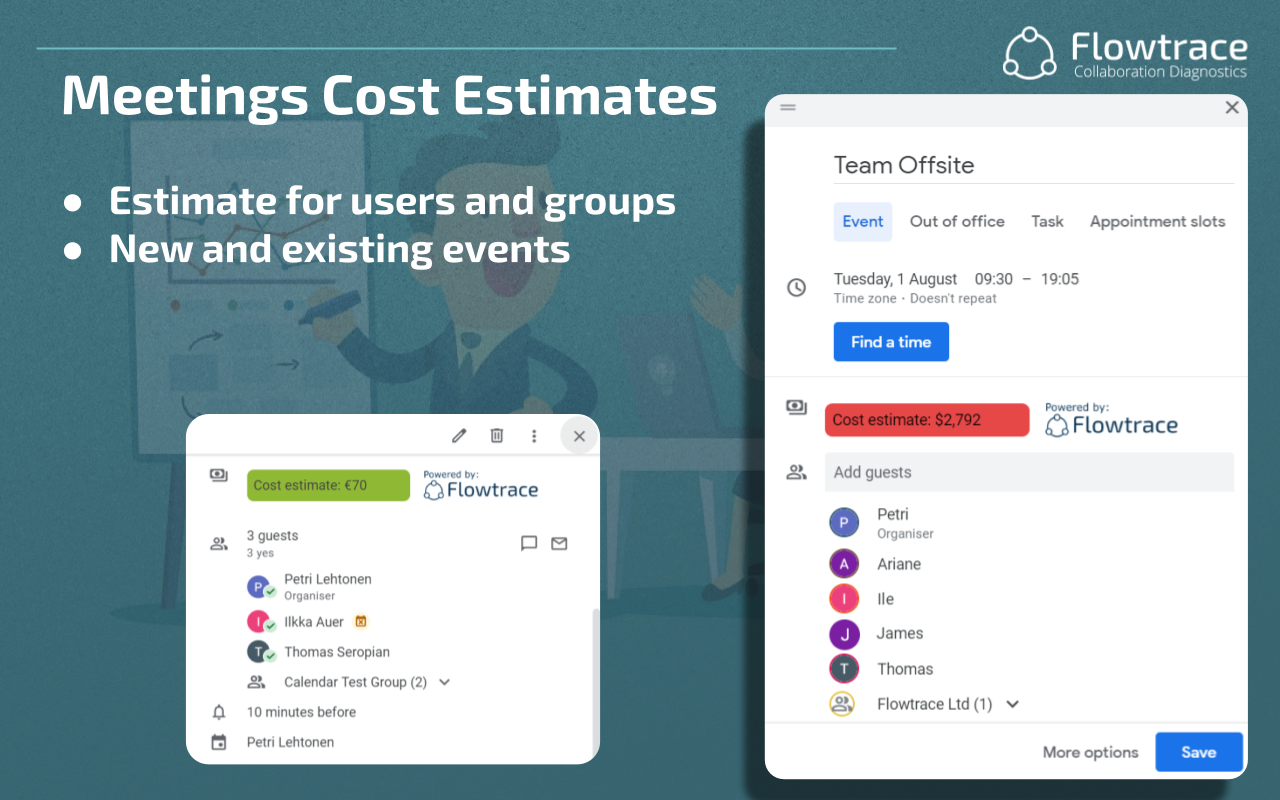Org-Wide Calendar Insights
Discover how org-wide calendar insights can transform meeting culture, reduce overload, and improve productivity with simple, actionable metrics and...
Discover how Flowtrace protects focus time by analyzing calendar patterns and improving meeting behaviors to boost productivity and reduce fragmentation in the workday.
Focus time protection isn’t about tracking keystrokes or monitoring screens. It’s about defending the hours that make real work possible, the uninterrupted blocks on your calendar that get sliced apart by meetings, pings, and “quick syncs.”
A true focus time protection tool understands the collaboration patterns that destroy hours. It observes how meetings cluster, how invitations multiply, and how context switching fractures the day - then addresses the problem where it begins: inside the calendar itself.
The payoff? Fewer broken mornings. Cleaner afternoons. And increased productivity.
Knowledge work today is defined by calendar density and constant context shifts. Hybrid schedules compress overlap hours, while chat and video create more occasions to meet. That is a recipe for fragmented attention. When deep work windows shrink, teams write more partial solutions, hold more rework meetings, and postpone decisions that require concentration.
Two studies show why protecting focus time belongs on every roadmap. McKinsey found that professionals spend about 28 percent of the workweek on email, a channel that tends to occupy the margins where focus would otherwise fit. This is time that rarely produces deep work by itself. That pattern puts pressure on the remaining hours to absorb the work that moves projects forward.
Harvard Business Review reported that newly promoted managers hold 29% more meetings than their experienced peers. That increase is small on paper but large in practice, because more meetings rarely spread evenly across the week. They cluster around the same midday overlap windows that makers rely on for complex tasks. The practical outcome is fewer contiguous blocks long enough to complete cognitively demanding work.
The best focus time protection tool does six things well.

Most focus time tools confuse measurement with understanding. They track keystrokes, idle minutes, and screen activity, as if productivity could be captured by a stopwatch. But timers can’t see what actually breaks focus. They only register that it’s gone.
.png?width=508&height=286&name=Marketing%20Images%20(11).png)
What fragments focus time in reality are patterns, specific, observable ones:
Real focus time protection starts by making these patterns visible, not by watching individuals, but by analyzing the system itself. It uses the data organizations already have, calendars, meetings, decisions, and collaboration signals, to show where fragmentation begins and how to prevent it.
That’s how focus time protection evolves from a personal habit into an operational discipline.
Below are the Flowtrace metrics and signals that help individuals understand where their time goes, and how easily it fragments. Each metric turns calendar and meeting data into insight, showing when focus time is protected and when it’s under pressure. Flowtrace’s approach is diagnostic, not invasive: it enables awareness and action, not monitoring.
Flowtrace identifies contiguous, meeting-free windows that meet your threshold for deep work, then trends the availability of those windows week over week. It surfaces how much focus time each team can realistically access, how often those blocks are cut by late invites, and whether overall availability is rising or falling.

Deep work requires an uninterrupted span. Measuring focus availability is how you know whether your calendar architecture allows the work that actually moves projects forward.
Total meeting hours, meeting counts, and average durations by team and function, with organization benchmarks and time trends. Flowtrace highlights where meeting load overlaps with planned focus windows.

Meeting quantity and placement jointly determine whether a 60 to 90 minute block survives. Knowing your load is step one in creating room for deep work.
When meetings occur by weekday and hour, with detection of back-to-back sequences and midday clusters that split the day. Flowtrace shows where the calendar makes blocks fragile and where refactoring creates space.
A week can have a normal total of meeting hours yet still be unfriendly to deep work because everything lands in the same overlap windows. Timing is a first-class input to focus protection.
Whether invites include meaningful agendas and whether meetings begin on time. Flowtrace flags sessions that start late or lack structure, which often spill into the next slot.

Missing agendas and late starts create follow-up meetings and overrun the blocks next to them. Small fixes here produce big gains in usable focus time.
Invite acceptance rates, declines, optional versus required participation, and no-show patterns. Flowtrace highlights rooms with excess spectators and recurring meetings that people accept by default. Flowtrace
Attendee bloat consumes live time and collapses focus windows for people who do not need to be there. Fixing this reduces conflict without hurting decisions.
Estimated cost per meeting and per attendee based on duration and roles, integrated into meeting analytics. Flowtrace uses this to show the price of low-intent live time and where cost crowds out focus hours.

Cost is a forcing function. When a recurring session consumes high cost and sits on top of prime focus time, it becomes easier to move, shorten, or replace with async.
Behavioral patterns around meetings that correlate with fragmentation, such as heavy synchronous communication weeks or frequent follow-up sessions caused by missing agendas. Flowtrace maps these signals to changes in focus availability.
A “free” calendar is not the same as a quiet one. Collaboration signals explain why some weeks feel chaotic even when the calendar looks open.
Back-to-back density, overlap with planned focus blocks, invite lead time, late-invite incidence, and other indicators of calendar structure. Flowtrace exposes repeated patterns that make deep work fragile and shows where stability can be restored.
Focus time protection is a calendar design problem. Structure tells you whether today’s reclaimed block will still exist next month.
Flowtrace does not try to infer deep work from keyboard activity. It reads the same calendars your teams already use and translates them into signals you can act on.

First, Flowtrace pairs a purpose-built focus time metric with practical meeting analytics. Focus availability is measured directly, then connected to the meeting behaviors that either protect or consume it. You see contiguous blocks, how often they are broken, and whether the trend is heading in the right direction.
Second, Flowtrace provides end-to-end visibility. You can see agenda hygiene, punctuality, attendance patterns, timing and clustering, and cost in one place. That lets teams solve root causes of fragmentation instead of chasing symptoms. The dashboards are designed to improve meeting culture by showing which behaviors to change and what happens when you do.
Third, the insights are calendar-native. Late-invite patterns, back-to-back sequences, and midday clusters show up where scheduling decisions happen. This matters because focus time protection fails when it requires manual policing. Integration with Outlook, Google Calendar, and conferencing platforms means the signal chain is consistent and the improvements stick.
Finally, Flowtrace helps you connect reclaimed focus hours to outcomes. When meeting load drops in the midday cluster and punctuality improves, you can watch contiguous blocks grow and compare that trend with fewer rollovers or faster cycle times on the work that matters. That is what makes focus time protection a practice, not a one-off initiative.
Focus time protection is a calendar and collaboration problem. It happens when you measure deep work windows, identify the meeting behaviors that shrink them, and fix those behaviors at the point of scheduling. Flowtrace turns that into a repeatable process by combining a focus time metric with meeting and calendar analytics that reveal timing, structure, attendance, and cost.
You can see where blocks are fragile, repair the architecture that makes them fragile, and track the improvement without monitoring individuals. The outcome is more uninterrupted time, fewer handoffs, and faster delivery, all from the data your calendars already contain.
Focus time is uninterrupted, meeting-free time reserved for cognitively demanding work. It’s the stretch of hours where strategy, design, writing, and problem-solving actually happen. Most teams treat 60–90 minutes as the minimum useful block, since anything shorter is easily lost to context switching.
Because focus time is where output quality and strategic work originate — and it’s the first casualty of poor meeting habits. Flowtrace protects it by analyzing calendar and meeting data to expose the patterns that fragment deep work: late invites, clustering, overruns, and attendance bloat. By making those patterns visible, it enables teams to rebuild calendars that hold their shape.
Yes. Flowtrace tracks invite lead time and late-invite frequency to show how often focus blocks are disrupted. These signals help teams set scheduling norms, compress recurring sessions, and protect reserved hours from last-minute collisions.
When focus availability trends upward and midday meeting density trends down, that’s real progress. Improvements in agenda presence and punctuality typically follow, reducing spillovers and creating more stable workdays. Flowtrace’s analytics make these relationships visible, so progress can be tracked and sustained.
Begin with the Meeting Analytics overview to baseline meeting load, timing, and agenda presence. Identify one friction point — such as dense meeting clusters or frequent late invites — and refactor that area first. Recheck focus availability after a few weeks to confirm gains and guide the next round of changes.
Discover how org-wide calendar insights can transform meeting culture, reduce overload, and improve productivity with simple, actionable metrics and...
Optimize your meeting efficiency by leveraging calendar analytics to reduce wasted time, protect focus, and enhance decision-making, leading to...
Combat meeting fatigue with a data-driven system that optimizes schedules, enforces agendas, and promotes focused work for fewer, more effective...